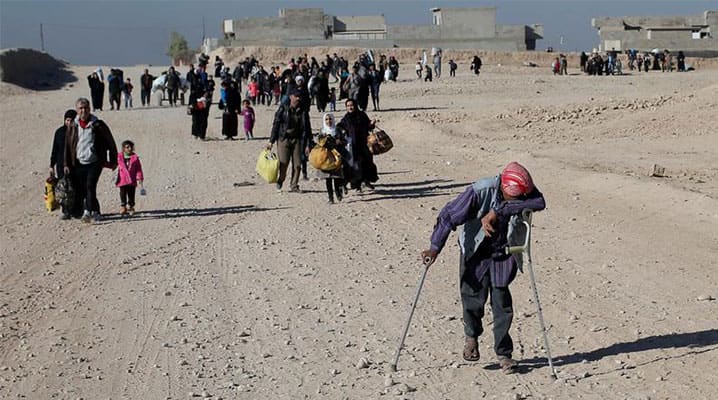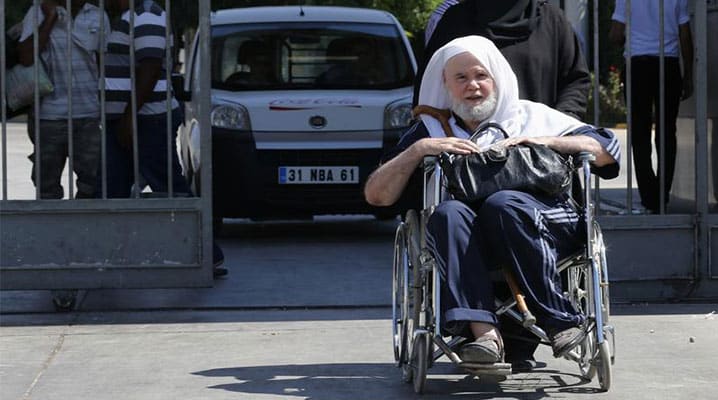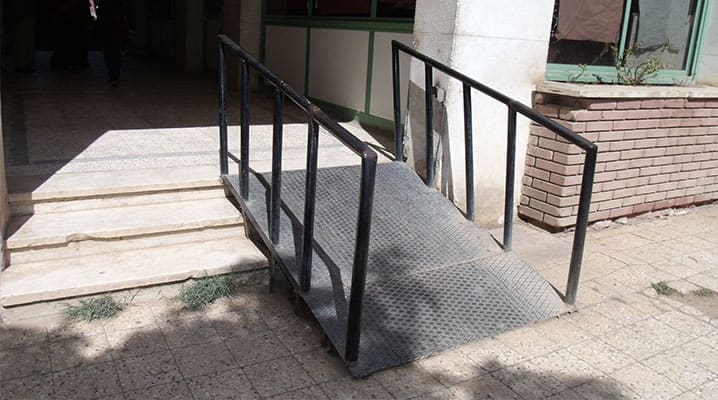People with disabilities rank high among those badly affected by conflict. For one thing, conflicts degrade whatever support systems are in existence. The lucky ones can flee – but many are forced by their circumstances to remain in the conflict zone after others have been evacuated, and are particularly vulnerable as a result.
The tendency in many countries to congregate people with disabilities into institutions creates heightened vulnerabilities that can complicate the task of civilian protection. History is replete with examples, for instance, the slaughter of civilians with disabilities at a psychiatric hospital during the Rwandan genocide or, earlier, under the Nazi T-4 programme of extermination of disabled adults and children in institutions and hospitals. Indeed, the very existence of clustered settlements – psychiatric hospitals, orphanages, social care homes and other institutions – can tempt some combatants to use people with disabilities as human shields.

A disabled man flees fighting between Iraqi forces and Islamic State fighters in Mosul, Iraq – 18 November 18, 2016. © REUTERS
People with physical, sensory as well as intellectual and psycho-social disabilities also face barriers in escaping and surviving armed conflict. Women with disabilities, already at a disproportionate risk for sexual violence during peace, are at an even greater risk of violence due to the insecurity of wartime. And of course, the intersection of disability with other characteristics such as race, religion, ethnic group, or age, for instance, further compounds the challenges during armed conflict.
The UN Disability Convention
In recent years, much research and development has been devoted to civilian protection during armed conflicts – and rightly so. That said, there is a major gap in current thinking about civilian protection, since little attention has been devoted to translating the generalities about civilian protection to persons with disabilities. From a purely legal point of view, it is also a gap that is no longer sustainable. The UN Convention on the Rights of Persons with Disabilities (Convention), adopted in 2006, is nearing universal ratification.
The UN Disability Convention has been described as marking a ‘paradigm shift’ in the way the world thinks about disability. It requires States Parties to identify and remove barriers in society for persons with disabilities and to align social and economic supports to assist in opening up equal opportunities. It requires that States take seriously the personhood of people with disabilities and especially their right to make their own choices about their lives. And, rather uniquely, the Convention also contains an article addressing their rights during “situations of risk and other humanitarian crises”.
This provision – Article 11 – is the bridge between the traditional field of civilian protection in international humanitarian law and the new field of the human rights of persons with disabilities. It calls for traditional civilian protection regimes to be broadened to encompass people with disabilities and specifically address their protection needs:
It reads:
“States Parties shall take, in accordance with their obligations under international law, including international humanitarian law and international human rights law, all necessary measures to ensure the protection and safety of persons with disabilities in situations of risk, including situations of armed conflict, humanitarian emergencies and the occurrence of natural disasters.[/I]”
The necessity of such protection is underscored in the Convention’s preamble which affirms that “the observance of applicable human rights instruments are indispensable for the full protection of persons with disabilities, in particular during armed conflicts and foreign occupation.”

A Syrian enters Turkey from the Turkish Cilvegozu border gate, located opposite the Syrian commercial crossing point Bab al-Hawa in Reyhanli, Hatay province – September 13, 2013. © REUTERS
Article 11 requires all actions to be taken in compliance with a States’ existing obligations under international law including both international humanitarian law and international human rights law. In a sense, it calls for the two sets of international law to be more meaningfully aligned. It specifically focuses on the protection and safety of people with disabilities during ‘armed conflicts’, exhorting States to move beyond simply identifying them in a laundry list of vulnerable groups requiring protection. Not everything in the Convention is relevant. So, Article 11 acts as a filter through which the relevant norms on civilian protection are brought into sharp focus. Some of the relevant provisions are highlighted below.
Key provisions
Targeting and rules of engagement
A consciousness of where people with disabilities live, how they typically move and react and their heightened vulnerabilities needs to be factored into targeting protocols and rules of engagement. This would seem to be a logical deduction from the right to life (Article 10) and the right to physical and mental integrity (Article 17). Gender responsiveness (Article 5) must also factor into any disability-sensitive calculus.
Humanitarian assistance
International humanitarian law requires that assistance and protection be afforded to the civilian population during armed conflict. Humanitarian relief access must be facilitated where the population cannot be adequately provided with food, water and medical supplies. In many instances, people with disabilities are among the least accessible members of a community in need of assistance, on account of isolation, restricted mobility, and communication or information barriers.
The Convention amplifies these protections for people with disabilities establishing obligations in respect of, for example, rehabilitation and the provision of assistance devices, and access to information (Articles 19, 26, 21). These Articles help to clarify the specific content of humanitarian assistance access in the context of disability.
Evacuation
The evacuation of people with disabilities in highly vulnerable situations is difficult at the best of times. Mobility impairments badly impact normal assumptions about routes of exit as well as the pace of movement. Inaccessible routes render self-evacuation virtually impossible. Those who assist are themselves highly vulnerable due to reduced speed. A sensory disability like blindness means that pamphlets advising civilians about exit routes cannot be read. Auditory warnings are likely of no use to some who is hard of hearing. An intellectual disability likely will mean that the importance of standard warnings may not be fully grasped or understood. A physical disability likely will mean that although the warning is comprehended, the individual may have no way to travel to the safe zones as available transport may be lacking in accessibility.

Safety depends on effective communication, which includes accommodating the needs of the deaf and others with sensory impairments.
Photo courtesy of Janet E. Lord
These are not insurmountable obstacles – but they all have to be intentionally thought through before intervening. Here, Article 5 (Equality – mandating an equal right to effective protection as well as ‘reasonable accommodation’ in whatever protection is provided), Article 9 (Accessibility) and Article 21 (Freedom of expression and access to information) inform and guide the way by which to take into account the needs of people with disabilities.
Immediate follow-through
Clearly, the specific health and other needs of people with disabilities are not resolved upon successful extrication from a conflict zone. That is not to say that most people with disabilities are sick, however, they may have specific habilitation and rehabilitation needs that are ongoing and, if not tended to, will lead to a deterioration in their condition. Further, accessibility to shelter, water and sanitation is essential to quality of life and poses health risks for disabled persons if not addressed. It is crucial that emergency responses, both immediate and long-term, do not lead to the (re)institutionalisation of people with disabilities, particularly in the case of children.
The Convention’s standards help set the stage for responsible and human rights-compliant programming later on, when at-risk populations take part in development and (re)construction processes. All of which brings into play Article 26 (Habilitation and Rehabilitation), Article 25 (Health) and Article 28 (Adequate Standard of Living). All who flee conflict will naturally try to stabilise their lives and put themselves in a position to resume their lives, depending on the situation on the ground.
Towards a more intentional conversation
It is clear that the Convention has opened the way for a much more intentional conversation about the meaning and application of the general provisions of the Convention in the specific context of humanitarian crises. In May 2016, at the World Humanitarian Summit in Istanbul, the Charter on the Inclusion of Persons with Disabilities in Humanitarian Action was adopted. The establishment of a Task Team on Disability Inclusion in Humanitarian Action within the UN Inter-Agency Standing Committee is an additional indicator of the pull towards disability inclusion in this area. These developments point to the need to inform this new dialogue, particularly insofar as it relates to civilian protection, and to seek to take better account of the needs of people with disabilities in the planning and conduct of operations.

Physical inaccessibility often seriously impedes evacuation efforts. Accessibility to shelter, water and sanitation also needs to be addressed, once people with mobility impairments have been extricated from conflict zones.
Photo courtesy of Janet E. Lord
At NATO’s Summit in Warsaw in July 2016, Allied leaders adopted the NATO Policy for the Protection of Civilians. It recognises that “all feasible measures must be taken to avoid, minimize and mitigate harm to civilians”, and that, “when planning, NATO should give consideration to those groups most vulnerable to violence within the local context.” Moreover, almost all NATO member states have ratified the UN Disability Convention and are therefore individually bound by the national interpretation of its provisions.
Ensuring the adequate protection of people with disabilities in humanitarian crises requires a well-integrated and implemented policy approach to drive field-based solutions. The Convention’s acknowledgement that persons with disabilities compel specific attention in international humanitarian law paves the way for a reappraisal of the ways in which men, women and children with disabilities experience armed conflict. NATO and its individual member states have an important role to play in carrying forward this important agenda.
